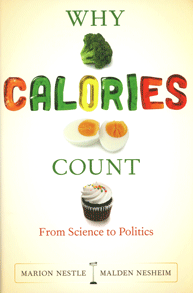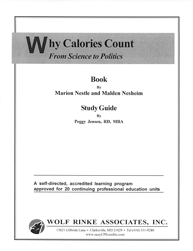|
Why Calories Count: From Science to Politics
Book by Marion Nestle and Malden Nesheim
Study Guide by Peggy Jensen, RD, MBA
| C239 |
20 CPEUs |
HARD COPY |
DISCONTINUED
|
|
Book, 304 pgs and Study Guide with 1 Reporting Form, 36 pgs.
Sorts through misinformation put forth by food manufacturers and diet program promoters, elucidates the political stakes and shows how federal and corporate policies have come together to create an “eat more” environment. Will enable you to help clients interpret food labels, evaluate diet claims, and understand evidence as presented in popular media. Upon completion of this self-study course you will be able to:
- Explain potential health effects from excessive fructose consumption;
- Assess toxic substances that build up from excessive alcohol intake;
- Categorize hormones into those that increase hunger and those that decrease hunger;
- Evaluate problems associated with the re-feeding process of under-nourished patients;
- Evaluate the potential detrimental effects of malnutrition in children.
For more information and customer comments, click
here.
Approved/Accepted by CDR, CBDM, NCBDE
For RDs/RDNs & DTRs/NDTRs for the Professional Development
Portfolio
SUGGESTED Learning Need Codes:
2000, 2020, 2070, 2110, 3000, 3005, 3020, 3030, 3040, 4000, 4030, 4040, 4070, 4130, 4140, 4150, 4180, 5000, 5125, 5260, 5280, 5370
SUGGESTED Performance Indicators (PIs):
3.3.5, 6.3.11, 7.1.4, 7.2.3, 7.2.4, 7.2.6, 8.1.4, 8.1.5, 8.2.1, 8.3.1, 8.3.6, 12.1.1, 12.1.3, 12.5.1, 12.5.4, 13.2.1
DON'T SEE your Performance Indicators or Code Listed here?
There are many Performance Indicators (PIs) that are applicable we can't list them all &
Per CDR you may use ANY PI or CODE as long as it relates to your Learning Plan.
For details click here.
Share with a friend and Save! Click here for important information about
sharing.
To order an ADDITIONAL Reporting Form click below:
| C239F |
20 CPEUs |
DISCONTINUED |
|
|
Why Calories Count: From Science to Politics
Book by Marion Nestle and Malden Nesheim
Study Guide by Peggy Jensen, RD, MBA
©2013 Wolf Rinke Associates. No part of this
publication may be reproduced, stored in a retrieval system, or transmitted
in any form or by any means, electronic, mechanical, photocopying,
recording, scanning, or otherwise, without the prior written permission
of the Publisher.
CUSTOMER COMMENTS
Jackie Schaffer: "I can carry with me & do work when a free time opens up. Very relevant."
Elizabeth Archambault: "The book was of great interest to me and important knowledge to review."
INTRODUCTION AND OVERVIEW
Welcome to Why Calories Count Study Guide, a self-directed accredited learning program. This program consists of a book of the same title by Marion Nestle and Malden Nesheim and this study guide.
This program is designed to provide you with a wide range of information to assist you in working with clients and patients who have concerns about calories and healthy diets, to assist you in any writing, media work, or presentations on nutritional policy, and to provide you with a wealth of practical information and support for you and your clients.
This learning program is approved for 20 continuing professional education units (CPEUs). It is a Level 2 Continuing Professional Education (CPE) program, meaning that the reader has general knowledge of the literature and professional practice within the areas covered. The focus of the program is to enhance knowledge and application when working with clients or the media.
To get the most out of this self-directed accredited learning program, it is suggested that you adhere to the following four steps:
Step 1: Review the objectives in this study guide.
Step 2: Read and study the Why Calories Count book.
Step 3: Assess what you have learned by answering the questions contained in this study guide.
Step 4: Compare your answers to the answer key provided in this study guide. If you score at least 80% correct, you are ready to transfer your answers to the CPE REPORTING FORM. If you scored less than 80% correct, re-read this learning program until you score at least 80% correct.
After you have successfully completed the program complete the CPE REPORTING FORM and
Submit on-line at www.easyCPEcredits.com,
Or fax to: (410) 531-9282,
Or mail to: Wolf Rinke Associates, 721 Valley Forge Road #486, Valley Forge, PA 19481.
We will e-mail your Certificate of Completion.
When you submit your CPE Reporting Form to us via www.easyCPEcredits.com, fax or mail be sure to write your correct email address in the space provided on the CPE Reporting Form. If writing by hand, be sure to print your e-mail address clearly.
To ensure that our e-mails are delivered to your inbox (instead of your junk/spam folders), please add cpesupport@wolfrinke.com to your Address Book or Safe List of allowed email senders. Also, be sure to allow attachments from this email address.
LEARNING OBJECTIVES
Upon completion of this accredited, self-directed learning program you will be able to:
-
Calculate a person’s Body Mass Index (BMI) given the weight and height;
-
Classify a person’s weight as underweight, normal weight, overweight, obese or extremely obese according to a person’s BMI;
-
Evaluate the multiple symptoms of metabolic syndrome;
-
Recommend the proportion of each food group recommended at a meal based on the USDA’s Choose My Plate food icon;
-
Explain potential health effects from excessive fructose consumption;
-
Describe the effect on blood glucose and satiety after eating foods with a low glycemic index;
-
Recommend foods that have a low glycemic index;
-
Describe the effect on blood glucose and fat storage after eating foods with a high glycemic index and identify foods that have a high glycemic index;
-
Explain the action of insulin on blood glucose;
-
Discuss changes in rules effective in 2010 because of the “Nutrition Labeling of Standard Menu Items at Chain Restaurants” section of the Health Care Reform Act regarding restaurants posting calorie counts of menu items;
-
Recommend additional number of calories per day to meet the needs of the fetus and the mother during the second and third trimesters of pregnancy;
-
Explain why a pregnant woman’s basal metabolic rate increases;
-
Discuss the information listed on the nutrition panel for packaged food and calculate the number of calories of an actual portion consumed based on the nutrition panel;
-
Explain free, low calorie, reduced calorie and light as used on food labels;
-
Compare the calorie content of regular beer versus light beer;
-
Calculate the calories of liquor given the proof and the volume;
-
Explain how alcohol is digested differently than food;
-
Assess toxic substances that builds up from excessive alcohol intake;
-
Describe the “health halo effect” and how it affects a consumer’s estimate of calorie content;
-
Explain basal metabolic rate (BMR);
-
Assess how age affects BMR;
-
Explain how to lower/raise BMR;
-
Describe the conditions necessary for researchers to accurately measure BMR;
-
Apply the Harris-Benedict equation;
-
Compare the various methods of measuring and estimating caloric expenditure in human subjects;
-
Using a reference chart, calculate the number of calories expended performing a specific activity for a specific duration;
-
Explain alternate stored energy sources from which the body can make glucose when carbohydrate intake is restricted;
-
Describe how the body gets rid of extra water when fed a low carbohydrate diet;
-
Specify the criteria for individuals to enroll in the National Weight Control Registry and three common practices of this group;
-
Explain how Xenical works and any possible negative side effects of this drug;
-
Itemize the diseases and conditions associated with obesity;
-
State the American Diabetes Association’s patient criteria for bariatric surgery;
-
Categorize the hormones into those that increase hunger and those that decrease hunger;
-
Explain why humans experience hunger;
-
Contrast the effects of glucagon and insulin on blood glucose levels and glycogen storage;
-
Describe the effects of leptin on how much animals eat;
-
Compare type 1 diabetes and type 2 diabetes regarding the insulin source (endogenous or exogenous) and how the body uses it;
-
Specify biomarkers associated with longevity in animal studies of calorie restricted diets;
-
Assess findings from the Comprehensive Assessment of Long-Term Effects of Reducing Intake of Energy (CALERIE) studies;
-
Explain the changes related to body fat levels, size of muscles, and the size of organs under semi-starvation conditions;
-
Evaluate problems associated with the re-feeding process of under-nourished patients;
-
Specify the statistical information that is gathered by the United Nations Food and Agricultural Organization (FAO);
-
Differentiate between the nutrients found in animal and plant foods;
-
Evaluate the potential detrimental effects of malnutrition in children;
-
Contrast the terms stunted, wasted, and underweight when children suffer from a protein-energy malnutrition;
-
Define the term “food insecure” as it relates to families;
-
Discuss the many causes of malnutrition.
TABLE OF CONTENTS
INTRODUCTION
PART ONE: Understanding Calories: It All Starts with the Science
What Is a Calorie?
The History: From Ancient Greece to Modern Calorie Science
Foods: How Scientists Count the Calories
Bodies: How Scientists Measure the Use of Calories
PART TWO: Why You Need Calories: Survival, Warmth, and Work
Metabolism: How the Body Turns Food into Energy
The First Use of Calories: Basic Life Functions
The Second Use: Heat Losses while Metabolizing Food
The Third Use: Physical Activity
PART THREE: Calorie Intake and Its Regulation
How Many Calories Do You Need?
Calorie Confusion: The Struggle to Estimate Intake
Secret Calories: Alcohol
Calorie Regulation: The Body's Complex Weight Management Syste
PART FOUR: Too Few Calories
Starvation and Its Effects on the Body
Individuals, Communities, Nations: Calories and Global Hunger
Could Restricting Calories Prolong Human Life?
PART FIVE: Too Many Calories
An Introduction to Obesity
Calories and Weight Gain: Another Complex Relationship
Do Excess Calories Make Some People Gain Weight Faster than Others?
Are All Calories Created Equal?
Do Some Kinds of Diets Work Better than Others?
PART SIX: The Politics of Calories: A Closer Look
Todays "Eat More" Environment: The Role of the Food Industry
More Calorie Confusion: Portion Distortion, Health Halos, and Wishful Thinking
Calorie Labeling: Science and Politics
Alcohol Labels: Industry vs. Consumers
Will Calorie Labels Help Fight Obesity?
Conclusion: How to Cope with the Calorie Environment
Appendix One. Selected Events in the History of Calories, 1614-1919
Appendix Two. The Respiratory Quotient (RQ)
Appendix Three. Frequently Asked Questions
Notes
List of Tables
List of Figures
Acknowledgments
Index
ABOUT THE AUTHORS OF THE BOOK
Marion Nestle is Paulette Goddard Professor in the Department of Nutrition, Food Studies, and Public Health and Professor of Sociology at New York University. She is the author of What to Eat and, from UC Press, Food Politics: How the Food Industry Influences Nutrition and Health, Safe Food: The Politics of Food Safety, and Pet Food Politics: The Chihuahua in the Coal Mine.
Malden Nesheim is Professor Emeritus and former Director of the Division of Nutritional Sciences at Cornell University. He is the coauthor (with Marion Nestle) of Feed Your Pet Right: The Authoritative Guide to Feeding Your Dog and Cat.
ABOUT THE AUTHOR OF THE STUDY GUIDE
Peggy Jensen, RD, MBA completed her dietetic internship at Massachusetts General Hospital and has more than twenty-five years experience as a registered dietitian. She has worked as a hospital-based, clinical dietitian, and coordinated a nutrition education program for the American Heart Association in New York. She has appeared on several cable television shows discussing healthy eating, shopping, and cooking. She is a contributing nutrition consultant for the recently published The 10 Best Questions for Recovering from a Heart Attack. Ms. Jensen currently works as an educator and nutrition consultant in private practice in Virginia.
Return to the top of page
If you prefer to order by phone, mail
or fax click below
or click here to contact us with
other questions.
For information about our other products and
services return to the sidebar at the top of the page.
|
|
|


